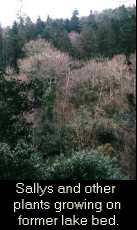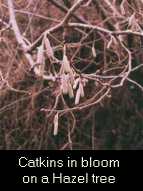










| |||
|
Stop 13
When you look down to the right you can see the colonisation
of what used
to be the lake bed.It is inhabited mostly by Willows,
also known as Sallys. Nettle and other hardy perennials also abound here.
Hopefully in the future the lake will be restored to its former beauty.
|

|
||
 Stop 14
The shrubs growing to the right and left of the path are called Bilberry
or Whortleberry.These produce edible fruits in the autumn called whorts.
If you stop and listen here, particularly in the morning, you
will hear a chorus
of bird song.The songsters include Wren, Robin, Blackbird, Song Thrush,
Blue Tit and Chaffinch.The river here is often visited by
the solitary Grey Heron.
Stop 14
The shrubs growing to the right and left of the path are called Bilberry
or Whortleberry.These produce edible fruits in the autumn called whorts.
If you stop and listen here, particularly in the morning, you
will hear a chorus
of bird song.The songsters include Wren, Robin, Blackbird, Song Thrush,
Blue Tit and Chaffinch.The river here is often visited by
the solitary Grey Heron.
| |||
Stop 15
These bushy multi-stemmed trees are Hazels.
 They are native trees.
They produce edible nuts in abundance and they are popular with
Red Squirrels
and small mammals such as Field Mice and Bank Voles.Contrary
to popular belief squirrels do not hibernate or store nuts
in any systematic fashion but continue to seek food during the
winter, even in very cold weather.
They are native trees.
They produce edible nuts in abundance and they are popular with
Red Squirrels
and small mammals such as Field Mice and Bank Voles.Contrary
to popular belief squirrels do not hibernate or store nuts
in any systematic fashion but continue to seek food during the
winter, even in very cold weather.
| |||
| HOME| PREVIOUS| START THE TRAIL| STOPS 1-3| STOPS 4-6| STOPS 7-9| STOPS 10-12| STOPS 16-18| GALLERY 1| GALLERY 2| GALLERY 3| GALLERY 4| BRIEF HISTORY| | |||
Website designed and maintained by Orla Irwin.